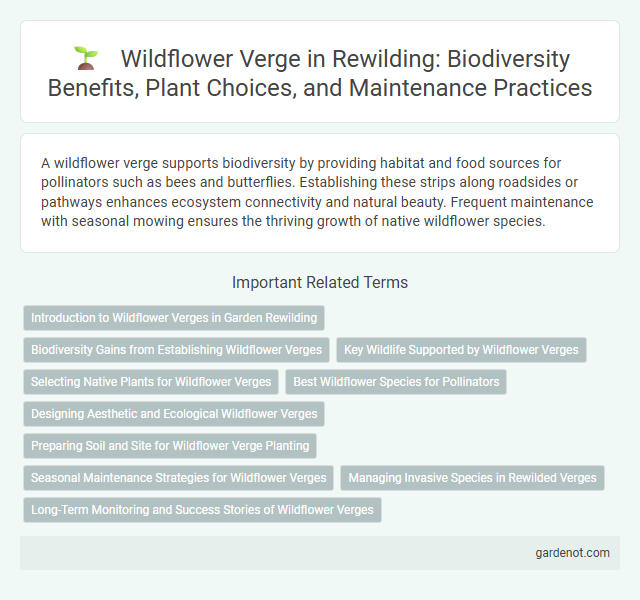A wildflower verge supports biodiversity by providing habitat and food sources for pollinators such as bees and butterflies. Establishing these strips along roadsides or pathways enhances ecosystem connectivity and natural beauty. Frequent maintenance with seasonal mowing ensures the thriving growth of native wildflower species.
Introduction to Wildflower Verges in Garden Rewilding
Wildflower verges play a crucial role in garden rewilding by providing essential habitats for pollinators such as bees, butterflies, and other beneficial insects. These strips of native wildflowers enhance biodiversity, improve soil health, and contribute to natural pest control by attracting a variety of wildlife. Incorporating wildflower verges in garden landscapes supports ecological balance and promotes a sustainable environment.
Biodiversity Gains from Establishing Wildflower Verges
Establishing wildflower verges significantly enhances local biodiversity by providing essential habitats for pollinators such as bees, butterflies, and other insects. These diverse plant species support a wider range of wildlife, including birds and small mammals, contributing to ecosystem stability and resilience. Wildflower verges also improve soil health and promote natural pest control, fostering a balanced and thriving environment.
Key Wildlife Supported by Wildflower Verges
Wildflower verges provide critical habitats for pollinators such as bees, butterflies, and hoverflies, enhancing biodiversity in urban and rural landscapes. These areas support native insect populations by offering nectar and pollen sources, which in turn sustain birds, small mammals, and amphibians reliant on insects for food. By fostering diverse plant species, wildflower verges create interconnected wildlife corridors essential for ecosystem resilience and rewilding efforts.
Selecting Native Plants for Wildflower Verges
Choosing native plants for wildflower verges enhances biodiversity by supporting local pollinators and wildlife. Native species such as oxeye daisy, bird's-foot trefoil, and common knapweed thrive in regional soil and climate conditions, ensuring sustainable growth with minimal maintenance. Incorporating a diverse mix of these native plants creates resilient habitats that boost ecosystem health and promote natural rewilding processes.
Best Wildflower Species for Pollinators
Wildflower verges rich in species like Cornflower (Centaurea cyanus), Oxeye Daisy (Leucanthemum vulgare), and Red Clover (Trifolium pratense) provide essential nectar and pollen sources for diverse pollinators, including bees, butterflies, and hoverflies. Incorporating native wildflowers such as Knapweed (Centaurea nigra) and Birdsfoot Trefoil (Lotus corniculatus) enhances habitat complexity and supports sustainable pollinator populations. Selecting a mix of early, mid, and late-flowering species ensures continuous forage availability throughout the growing season, maximizing pollinator attraction and ecosystem benefits.
Designing Aesthetic and Ecological Wildflower Verges
Designing aesthetic and ecological wildflower verges involves selecting native plant species that provide vibrant seasonal blooms and support local pollinators such as bees and butterflies. Incorporating diverse wildflowers enhances soil health, reduces maintenance needs, and creates visually appealing habitats along roadsides and urban spaces. Strategic planting patterns and mowing regimes maximize biodiversity while sustaining the verge's beauty and ecological function.
Preparing Soil and Site for Wildflower Verge Planting
Preparing soil for wildflower verge planting involves removing existing vegetation and loosening compacted soil to enhance seed-to-soil contact. Conducting a soil test helps determine pH levels and nutrient availability, ensuring optimal conditions for native wildflower species. Site selection should prioritize well-drained areas with adequate sunlight exposure to support diverse wildflower growth and long-term ecosystem restoration.
Seasonal Maintenance Strategies for Wildflower Verges
Seasonal maintenance strategies for wildflower verges emphasize timing cuts to promote biodiversity, typically involving a late summer mow followed by removal of cuttings to prevent nutrient buildup and encourage native wildflowers. Spring and early summer require minimal intervention, allowing seedlings to establish and flower species to complete their life cycles. Regular monitoring during peak growing seasons ensures invasive species are controlled without disrupting the ecosystem's natural balance.
Managing Invasive Species in Rewilded Verges
Managing invasive species in rewilded wildflower verges is crucial to maintaining biodiversity and supporting native pollinators. Regular monitoring and targeted removal of aggressive non-native plants prevent them from outcompeting indigenous wildflowers. Employing native plant propagation and adaptive management techniques enhances the resilience and ecological balance of these rewilded habitats.
Long-Term Monitoring and Success Stories of Wildflower Verges
Long-term monitoring of wildflower verges reveals increased biodiversity, with native pollinators such as bees and butterflies showing significant population growth over multiple years. Success stories from regions like the UK demonstrate that carefully managed wildflower verges improve ecosystem services, including soil health and carbon sequestration. Data from these projects highlight sustained floral diversity and habitat connectivity as key indicators of effective rewilding strategies.
Wildflower verge Infographic

 gardenot.com
gardenot.com